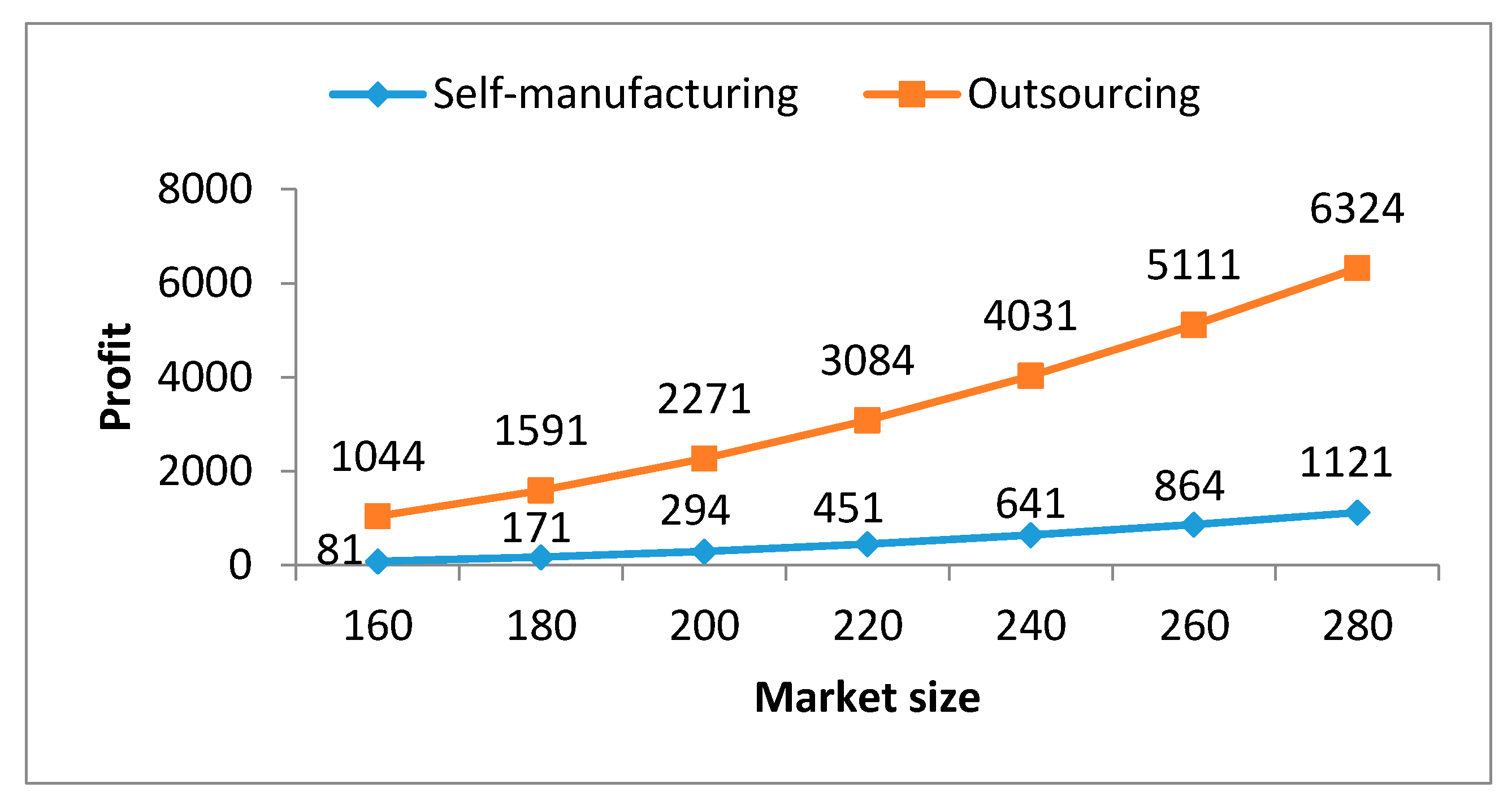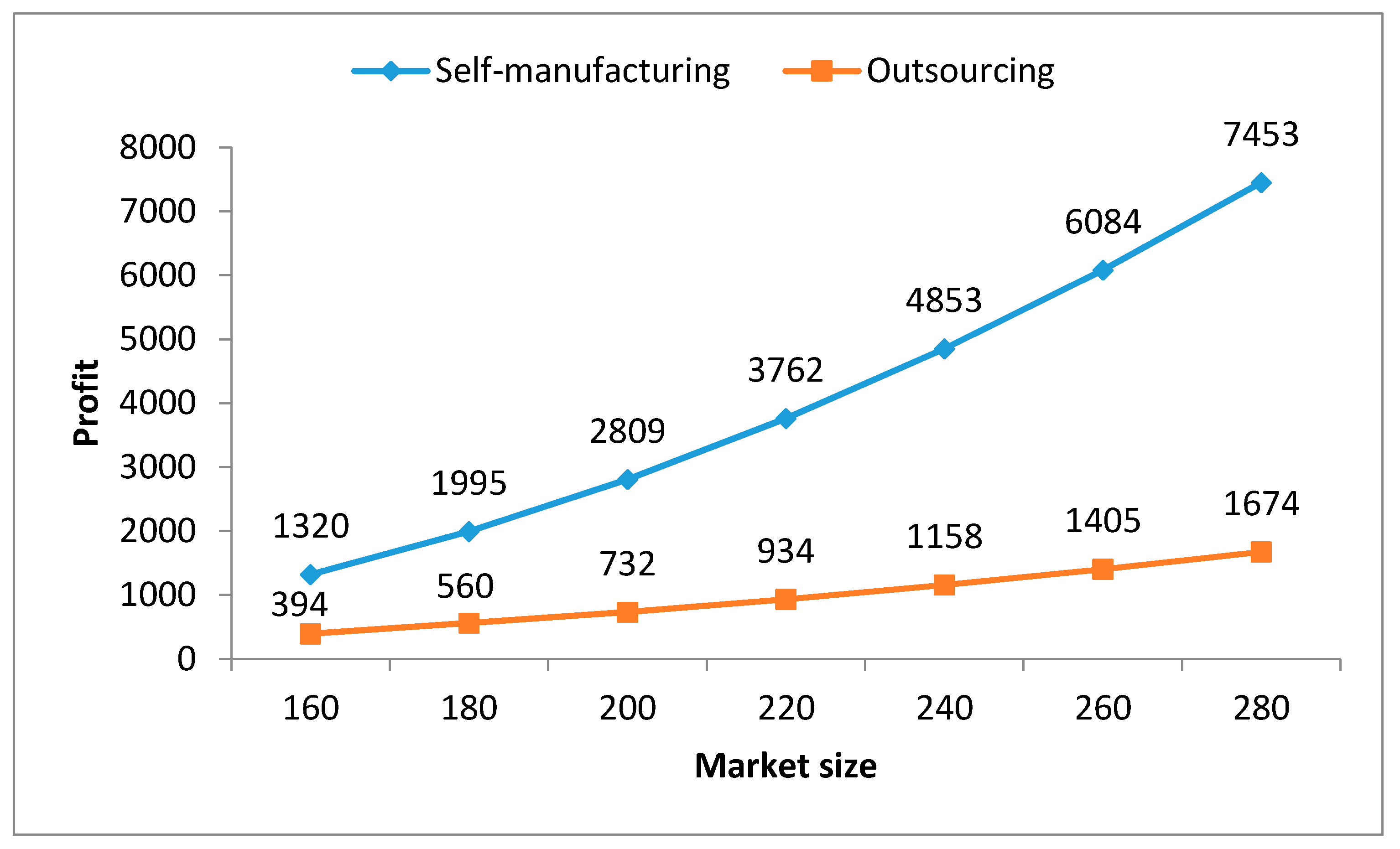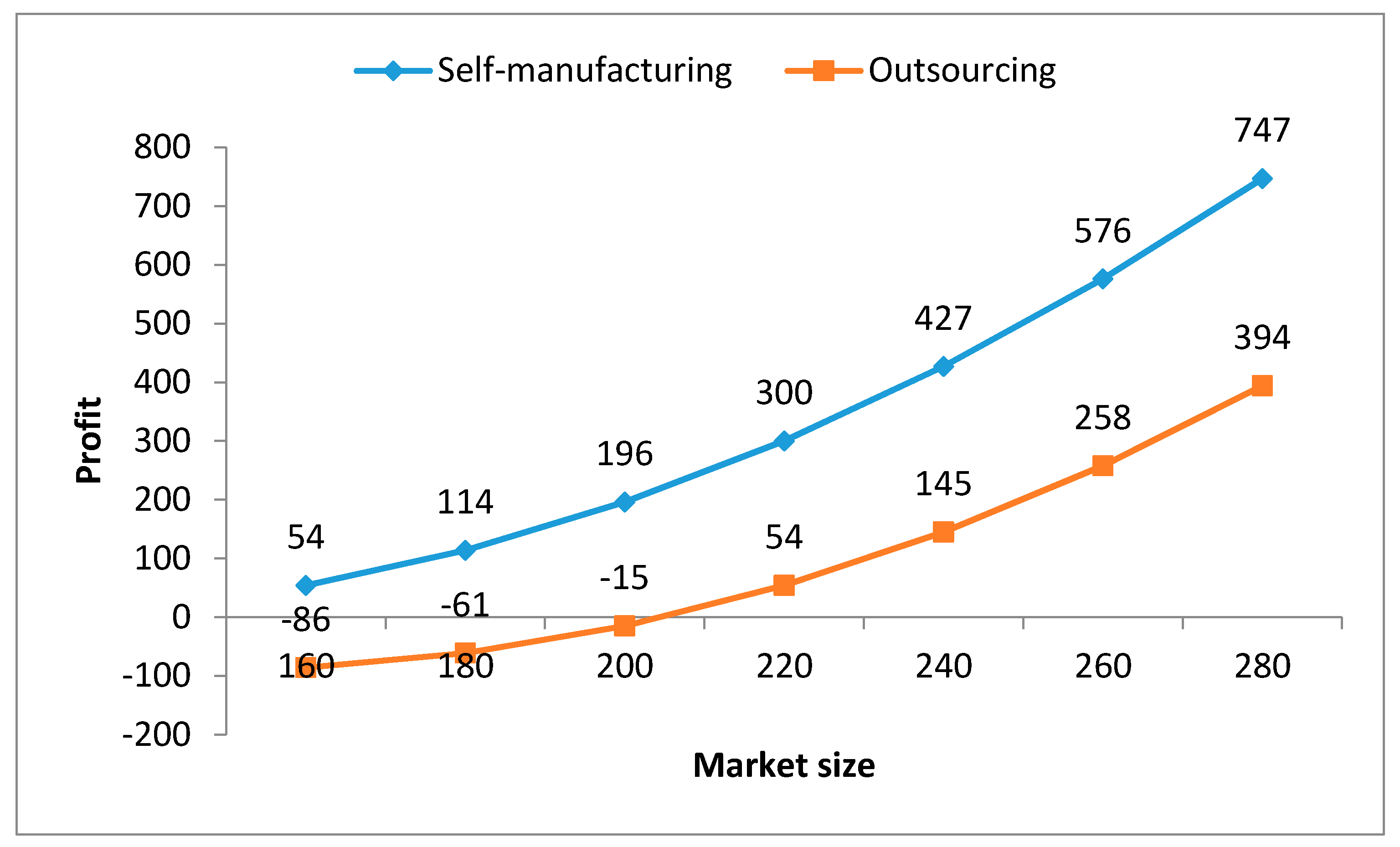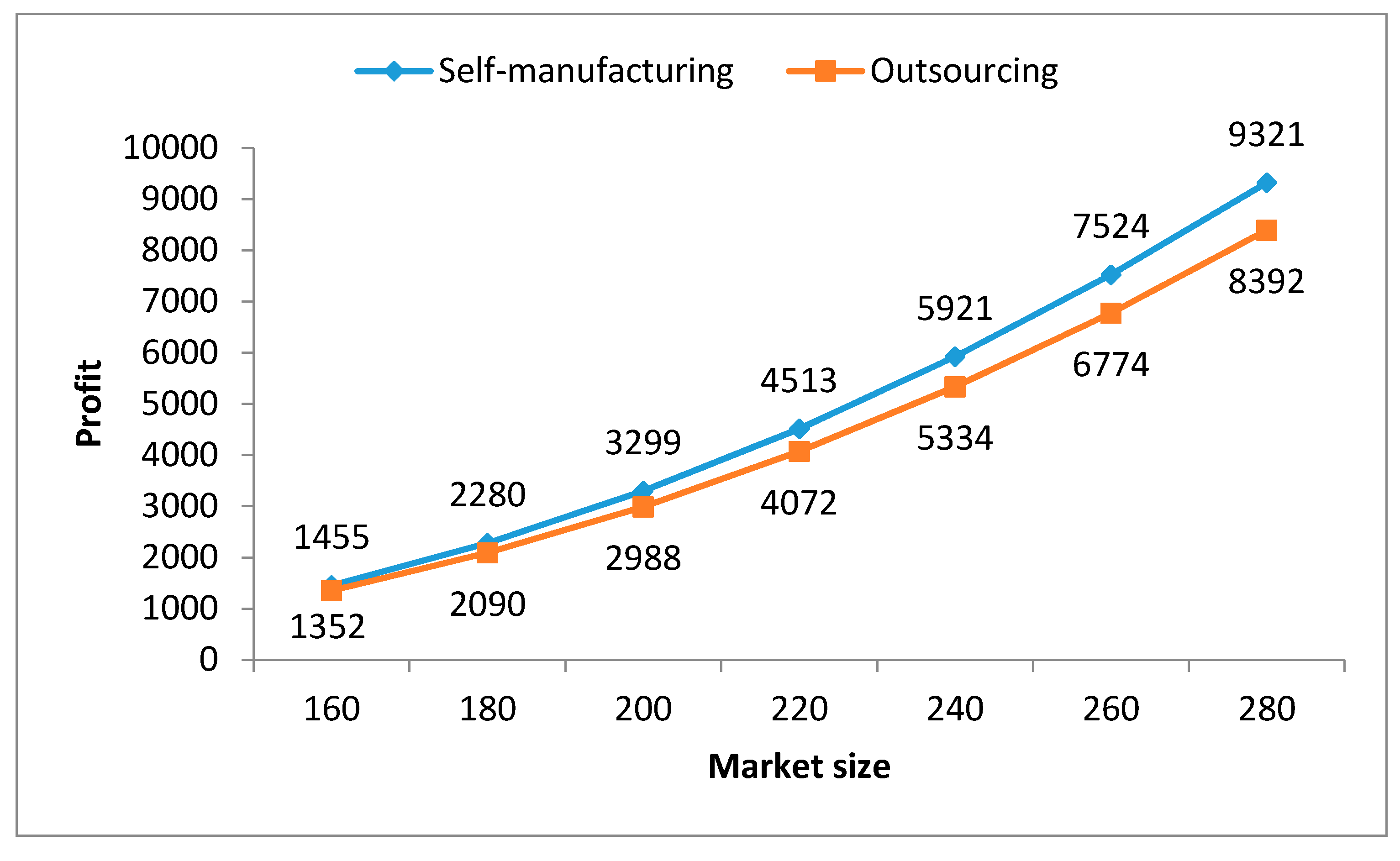A Market Equilibrium Supply Chain Model for Supporting Self-Manufacturing or Outsourcing Decisions in Prefabricated Construction
Abstract
:1. Introduction
- For the large construction enterprises, should the structural components be precast through establishing self-owned factory (i.e., self-manufacturing) or supplied by upstream independent component manufacturers (i.e., outsourcing)?
- For the small and medium-sized enterprises (SMEs) in construction, how do they participate in the prefabricated construction industry, considering that they have no independent component production capacity?
- What impacts does the self-manufacturing or outsourcing decision have on the whole supply chain, the different enterprises, and the prefabricated construction industry?
2. Background
2.1. Supply Chain Management in Prefabricated Construction
2.2. Cournot-Stackelberg Model
3. Research Methodology
3.1. Game-Theoretic Analysis
3.1.1. Assumptions
3.1.2. Component Self-Manufacturing Decision
3.1.3. Component Outsourcing Decision
3.2. Numerical Simulation
4. Results and Discussions
4.1. Comparative Analysis under Self-Manufacturing and Outsourcing Decisions
4.2. Results and Discussions for Numerical Simulation
5. Managerial Implications
6. Conclusions and Future Research Directions
Acknowledgments
Author Contributions
Conflicts of Interest
Appendix A
| Notation | Meaning | Notation | Meaning |
|---|---|---|---|
| Profit of Component Supplier S under self-manufacturing decision | Profit of Component Supplier S under outsourcing decision | ||
| Profit of Contractor A under self-manufacturing decision | Profit of Contractor A under outsourcing decision | ||
| Profit of Contractor B under self-manufacturing decision | Profit of Contractor B under outsourcing decision | ||
| Production quantity of Contractor A | Market size | ||
| Production quantity of Contractor B | Market equilibrium price, | ||
| Assembly cost of Contractor A | Unit production cost of Component Supplier S | ||
| Assembly cost of Contractor B | Unit self-manufacturing cost of Contractor A | ||
| Unit purchase price of Contractor B under self-manufacturing decision | Unit purchase price of Contractor A and B under outsourcing decision, |
References
- Chen, Y.; Okudan, G.E.; Riley, D.R. Decision support for construction method selection in concrete buildings: Prefabrication adoption and optimization. Autom. Constr. 2010, 19, 665–675. [Google Scholar] [CrossRef]
- Arif, M.; Egbu, C. Making a case for offsite construction in China. Eng. Constr. Archit. Manag. 2010, 17, 536–548. [Google Scholar] [CrossRef]
- Aye, L.; Ngo, T.; Crawford, R.H.; Gammampila, R.; Mendis, P. Life cycle greenhouse gas emissions and energy analysis of prefabricated reusable building modules. Energy Build. 2012, 47, 159–168. [Google Scholar] [CrossRef]
- Mao, C.; Shen, Q.; Shen, L.; Tang, L. Comparative study of greenhouse gas emissions between off-site prefabrication and conventional construction methods: Two case studies of residential projects. Energy Build. 2013, 66, 165–176. [Google Scholar] [CrossRef]
- Xu, X.; Zhao, Y. Some Economic Facts of the Prefabricated Housing; Industry Report; Rutgers Business School: Newark, NJ, USA, 2010. [Google Scholar]
- Jaillon, L.; Poon, C.S. The evolution of prefabricated residential building systems in Hong Kong: A review of the public and the private sector. Autom. Constr. 2009, 18, 239–248. [Google Scholar] [CrossRef]
- Polat, G. Precast concrete systems in developing vs. industrialized countries. J. Civ. Eng. Manag. 2010, 16, 85–94. [Google Scholar] [CrossRef]
- Goodier, C.I.; Gibb, A.G.F. Barriers and Opportunities for Offsite in the UK. In Systematic Innovation in the Management of Project and Processes, Proceedings of the 11th Joint CIB International Symposium Combining Forces—Advancing Facilities Management and Construction through Innovation, Helsinki, Finland, 13–16 June 2005; Abdul, S.K., Ed.; Loughborough University: Leicestershire, UK, 2005; pp. 148–158. [Google Scholar]
- Kamar, K.A.M.; Alshawi, M.; Hamid, Z.A. Barriers To Industrialized Building System (IBS): The Case of Malaysia. In Proceedings of the BuHu 9th International Postgraduate Research Conference (IPGRC), Salford, UK, 29–30 January 2009; pp. 1–16. [Google Scholar]
- Yue, Y.D.; Yin, J.Y. Economic dynamics analysis on supply chain strategic alliance in the new construction industrialization. J. Hunan Univ. Soc. Sci. 2014, 28, 45–49. [Google Scholar]
- Čuš-Babič, N.; Rebolj, D.; Nekrep-Perc, M.; Podbreznik, P. Supply-chain transparency within industrialized construction projects. Comput. Ind. 2014, 65, 341–353. [Google Scholar] [CrossRef]
- Abedi, M.; Fathi, M.S.; Mirasa, A.K.; Rawai, N.M. Integrated collaborative tools for precast supply chain management. Sci. Iran. Trans. A Civ. Eng. 2016, 23, 429–448. [Google Scholar] [CrossRef]
- Hu, M.; Jiang, Z.H.; Du, J. Platform design and transport management research of prefabricated concrete components supply chain. House Ind. 2015, 10, 41–45. [Google Scholar]
- Zeng, T.; Qiu, K.N.; Li, Y.G. Research on digital lean construction platform of prefabricated concrete components based on supply chain. Inf. Technol. Civ. Eng. Constr. 2013, 5, 34–39. [Google Scholar]
- Kamar, K.A.M.; Hamid, Z.A. Supply Chain Strategy for Contractor in Adopting Industrialized Building System (IBS). Aust. J. Basic Appl. Sci. 2011, 5, 2552–2557. [Google Scholar]
- Ko, C. Production control in precast fabrication: Considering demand variability in production schedules. Can. J. Civ. Eng. 2011, 38, 191–199. [Google Scholar] [CrossRef]
- Ko, C.; Wang, S. GA-based decision support systems for precast production planning. Autom. Constr. 2010, 19, 907–916. [Google Scholar] [CrossRef]
- Ko, C.; Wang, S. Precast production scheduling using multi-objective genetic algorithms. Expert Syst. Appl. 2011, 38, 8293–8302. [Google Scholar] [CrossRef]
- Anvari, B.; Angeloudis, P.; Ochieng, W.Y. A Multi-Objective GA-based Optimization for Holistic Manufacturing, transportation and Assembly of Precast Construction. Autom. Constr. 2016, 71, 226–241. [Google Scholar] [CrossRef]
- Shan, Y.H.; Li, Z.F. Knowledge sharing evolution game in the building supply chain for construction industrialization. J. Eng. Manag. 2015, 29, 1–5. [Google Scholar]
- Lambert, D.M.; Cooper, M.C.; Pagh, J.D. Supply chain management: Implementation issues and research opportunities. Int. J. Logist. Manag. 1998, 9, 1–20. [Google Scholar] [CrossRef]
- Mentzer, J.T.; DeWitt, W.; Keebler, J.S.; Min, S.; Nix, N.W.; Smith, C.D.; Zacharia, Z.G. Defining supply chain management. J. Bus. Logist. 2001, 22, 1–25. [Google Scholar] [CrossRef]
- Houlihan, J.B. International Supply Chains: A New Approach. Manag. Decis. 1988, 26, 13–19. [Google Scholar] [CrossRef]
- Tyndall, G.; Gopal, C.; Partsch, W.; Kamauff, J. Supercharging Supply Chains: New Ways to Increase Value Through Global Operational Excellence; John Wiley & Sons: Hoboken, NJ, USA, 1998. [Google Scholar]
- Ross, D.F. Competing through Supply Chain Management; Springer: Berlin, Germany, 1998. [Google Scholar]
- Cooper, M.C.; Lambert, D.M.; Pagh, J.D. Supply Chain Management: More Than a New Name for Logistics. Int. J. Logist. Manag. 1997, 8, 1–14. [Google Scholar] [CrossRef]
- Cooper, M.C.; Ellram, L.M.; Gardner, J.T.; Hanks, A.M. Meshing Multiple Alliances. J. Bus. Logist. 1997, 18, 67–89. [Google Scholar]
- Cooper, M.C.; Ellram, L.M. Characteristics of Supply Chain Management and the Implication for Purchasing and Logistics Strategy. Int. J. Logist. Manag. 1993, 4, 13–24. [Google Scholar] [CrossRef]
- Ellram, L.M.; Cooper, M.C. Supply Chain Management, Partnerships, and the Shipper-Third-Party Relationship. Int. J. Logist. Manag. 1990, 1, 1–10. [Google Scholar] [CrossRef]
- La Londe, B.J.; Masters, J.M. Emerging logistics strategies: Blueprints for the next century. Int. J. Phys. Distrib. Logist. Manag. 1994, 24, 35–47. [Google Scholar] [CrossRef]
- La Londe, B.J. Supply Chain Management: Myth or Reality. Supply Chain Manag. Rev. 1997, 1, 6–7. [Google Scholar]
- Burgess, K.; Singh, P.J.; Koroglu, R. Supply chain management: A structured literature review and implications for future research. Int. J. Oper. Prod. Manag. 2006, 26, 703–729. [Google Scholar] [CrossRef]
- Abduh, M.; Soemardi, B.W.; Wirahadikusumah, R.D. Indonesian Construction Supply Chains Cost Structure and Factors: A Case Study of Two Projects. J. Civ. Eng. Manag. 2012, 18, 209–216. [Google Scholar] [CrossRef]
- Yeo, K.T.; Ning, J.H. Integrating supply chain and critical chain concepts in engineer-procure-construct (EPC) projects. Int. J. Proj. Manag. 2002, 20, 253–262. [Google Scholar] [CrossRef]
- Irizarry, J.; Karan, E.P.; Jalaei, F. Integrating BIM and GIS to improve the visual monitoring of construction supply chain management. Autom. Constr. 2013, 31, 241–254. [Google Scholar] [CrossRef]
- Xue, X.; Wang, Y.; Shen, Q.; Yu, X. Coordination mechanisms for construction supply chain management in the Internet environment. Int. J. Proj. Manag. 2007, 25, 150–157. [Google Scholar] [CrossRef]
- Pan, N.-H.; Lee, M.-L.; Chen, S.-Q. Construction material supply chain process analysis and optimization. J. Civ. Eng. Manag. 2011, 17, 357–370. [Google Scholar] [CrossRef]
- Parunak, H.V.; Savit, R.; Riolo, R.L. Agent-based modeling vs. equation-based modeling: A case study and users’ guide. In Proceedings of the Multi-Agent Systems and Agent-Based Simulation, MABS ’98, Paris, France, 4–6 July 1998; pp. 10–25. [Google Scholar]
- Anumba, C.J.; Ugwu, O.O.; Newnham, L.; Thorpe, A. Collaborative design of structures using intelligent agents. Autom. Constr. 2002, 11, 89–103. [Google Scholar] [CrossRef]
- Pena-Mora, F.; Wang, C.Y. Computer-supported collaborative negotiation methodology. J. Comput. Civ. Eng. 1998, 12, 64–81. [Google Scholar] [CrossRef]
- Xue, X.; Li, X.; Shen, Q.; Wang, Y. An agent-based framework for supply chain coordination in construction. Autom. Constr. 2005, 14, 413–430. [Google Scholar] [CrossRef]
- Tesfatsion, L. Agent-based Computational Economics: A constructive approach to economic theory. In Handbook of Computational Economics; Elsevier: Amsterdam, The Netherlandsm, 2005; Volume 2, p. 55. [Google Scholar]
- Marceau, J.; Houghton, J.; Toner, P.; Manley, K.; Gerasimou, E.; Cook, N. Mapping the Building and Construction Product System in Australia; Commonwealth Department of Industry, Science and Resources: Sydney, Australia, 1999. [Google Scholar]
- Tremblay, V.J.; Tremblay, C.H. Quantity and Price Competition in Static Oligopoly Models. New Perspect. Ind. Organ. 2012. [Google Scholar] [CrossRef]
- Aloini, D.; Dulmin, R.; Mininno, V.; Ponticelli, S. Supply Chain Management: A Review of Implementation Risks in the Construction Industry. Bus. Process Manag. J. 2012, 18, 735–761. [Google Scholar] [CrossRef]
- Zhang, X.; Skitmore, M. Industrialized housing in China: A coin with two sides. Int. J. Strateg. Prop. Manag. 2012, 16, 143–157. [Google Scholar] [CrossRef]




| Decisions of Contractor A | Self-Manufacturing | Outsourcing | |
|---|---|---|---|
| Market equilibrium price | |||
| Equilibrium output | Contractor A | ||
| Contractor B | |||
| Profit | Upstream Component Supplier S | ||
| Contractor A | |||
| Contractor B | |||
| Market Size | Profit When Self-Manufacturing | Profit When Outsourcing | ||||||
|---|---|---|---|---|---|---|---|---|
| Component Supplier S | Contractor A | Contractor B | Supply Chain | Component Supplier S | Contractor A | Contractor B | Supply Chain | |
| 160 | 81 | 1320 | 54 | 1455 | 1044 | 394 | −86 | 1352 |
| 180 | 171 | 1995 | 114 | 2280 | 1591 | 560 | −61 | 2090 |
| 200 | 294 | 2809 | 196 | 3373 | 2271 | 732 | −15 | 2988 |
| 220 | 451 | 3762 | 300 | 4513 | 3084 | 934 | 54 | 4072 |
| 240 | 641 | 4853 | 427 | 5921 | 4031 | 1158 | 145 | 5334 |
| 260 | 864 | 6084 | 576 | 7524 | 5111 | 1405 | 258 | 6774 |
| 280 | 1121 | 7453 | 747 | 9321 | 6324 | 1674 | 394 | 8392 |
© 2017 by the authors. Licensee MDPI, Basel, Switzerland. This article is an open access article distributed under the terms and conditions of the Creative Commons Attribution (CC BY) license (http://creativecommons.org/licenses/by/4.0/).
Share and Cite
Han, Y.; Skibniewski, M.J.; Wang, L. A Market Equilibrium Supply Chain Model for Supporting Self-Manufacturing or Outsourcing Decisions in Prefabricated Construction. Sustainability 2017, 9, 2069. https://doi.org/10.3390/su9112069
Han Y, Skibniewski MJ, Wang L. A Market Equilibrium Supply Chain Model for Supporting Self-Manufacturing or Outsourcing Decisions in Prefabricated Construction. Sustainability. 2017; 9(11):2069. https://doi.org/10.3390/su9112069
Chicago/Turabian StyleHan, Yanhu, Miroslaw J. Skibniewski, and Lufan Wang. 2017. "A Market Equilibrium Supply Chain Model for Supporting Self-Manufacturing or Outsourcing Decisions in Prefabricated Construction" Sustainability 9, no. 11: 2069. https://doi.org/10.3390/su9112069
APA StyleHan, Y., Skibniewski, M. J., & Wang, L. (2017). A Market Equilibrium Supply Chain Model for Supporting Self-Manufacturing or Outsourcing Decisions in Prefabricated Construction. Sustainability, 9(11), 2069. https://doi.org/10.3390/su9112069





